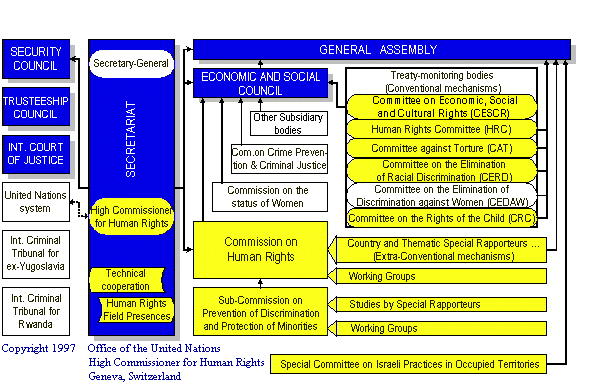
III-f. Human Rights Agencies
Human rights generally belong to individual persons, although in some contexts rights are associated with groups of individuals. The obligations associated with particular human rights rest primarily with governments. Other have some obligations as well. For example, individuals should not interfere with other individuals’ human rights. It is government’s responsibility to see that they do not.
From a strictly legal perspective, only states can violate international human rights law directly, since only states are parties to the international human rights agreements. However, implementing legislation at the national level may explicitly spell out obligations of other parties in the nation's jurisdiction. Thus, private citizens and nongovernmental organizations that violate this national legislation would, indirectly, also be violating the norms of international human rights.
Governance in the world is exercised mainly through nested layers of government ranging from village and townships, through cities, counties, provinces, and nation-states, and--at the global level--the nascent governance administered through the international community, primarily the United Nations. Since it is "States Parties" that sign and ratify the human rights agreements, it is these nation-states, and the governments that represent them, that have primary responsibility for implementing these human rights.
Most national governments have particular agencies in the executive branch that take the leading role in dealing with human rights issues. In the United States, for example, the Department of Justice oversees the implementation of human rights within the country, while the Department of State has primary responsibility for its international dimensions. About fifty countries now have national human rights commissions.
While national governments have primary responsibility for the implementation of human rights there are other bodies within nations, both governmental and nongovernmental, that play a supporting role. For example, when the national government commits the nation-state to implementing particular human rights, responsibility for implementation may devolve to other levels of government such as provincial or county or municipal governments. Civil society organizations may be assigned some responsibility either for implementing rights directly or for monitoring the government’s performance in implementing human rights. Most civil societyl organizations concerned with human rights operate within single countries, but some are international in their coverage. (A list of some of them is provided in Subsection III-j). The roles of civil society organizations are discussed further in the three concluding subsections of this section of the tutorial.
Apart from those explicitly designated as human rights bodies, there are many international bodies that also play roles in relation to human rights as part of their broader mandates. These include regional bodies dedicated to carrying out the regional human rights agreements described in the preceding section. They also include international nongovernmental organizations (INGOs), or in the emerging language, international civil society organizations (ICSOs). Of course, the major international bodies involved in human rights are the United Nations agencies, described in the two following sections. Many of these bodies, global and regional, governmental and nongovernmental are described in the Yearbook of International Organizations.
There are many different bodies in the United Nations system that play a role with regard to human rights. There are two major groups, those that have been created, directly or indirectly, on the basis of the Charter of the United Nations, and those that have been created by, or in connection with, specific international treaties. A diagram showing the relationships among the UN's human rights bodies is provided here.

Figure III-1. Human Rights Bodies at the United Nations
(Source: UNHCHR Website, February 1999)
The blue (black when printed out) areas indicate six principle organs of the United Nations, whereas the yellow (grey) ones indicate bodies or programmes serviced by the Office of the United Nations High Commissioner for Human Rights. At this chart on the UNHCHR website (http://www.unhchr.ch/hrostr.htm), clicking on the titles of specific bodies will lead to additional information on them.
Apart from these bodies, many of the UN specialized agencies, financial institutions, and funds play important roles in the realization of human rights. These include agencies such as the World Bank, the Food and Agriculture Organization of the United Nations, the World Health Organization, the United Nations Children's Fund, the United Nations Development Program, the United Nations Fund for Population Activities, and others.
Continue to III-g. United Nations Charter Bodies
Subsection III-f last updated on September 15, 1999